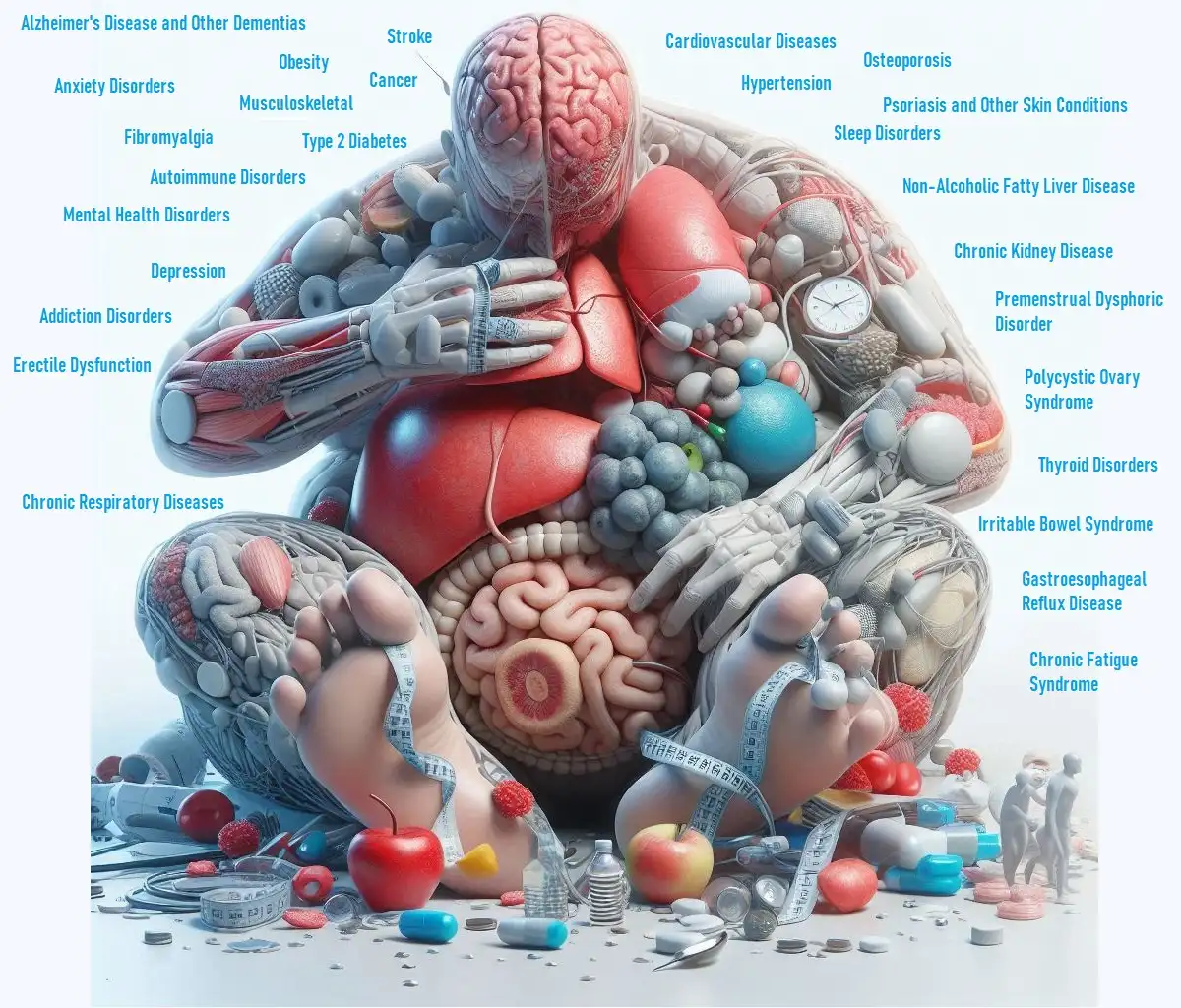
Non-Alcoholic Fatty Liver Disease (NAFLD) is a growing concern affecting millions worldwide. It ranges from simple fat accumulation in the liver to more severe conditions like liver fibrosis. Understanding how to detect NAFLD early, the role of obesity, and other factors like choline, type 2 diabetes, and high fructose corn syrup can empower you to take control of your liver health.
Key Takeaways
- Early Detection: Catching NAFLD early can prevent progression to more serious liver damage.
- Obesity: Excess weight significantly accelerates NAFLD progression.
- Choline: This nutrient plays a crucial role in preventing NAFLD.
- Type 2 Diabetes: There is a strong connection between NAFLD and type 2 diabetes.
- High Fructose Corn Syrup: This sweetener can worsen NAFLD by increasing liver fat.
NAFLD and Liver Fibrosis: Early Detection
What Is Liver Fibrosis?
Liver fibrosis is the buildup of scar tissue in the liver caused by ongoing damage and inflammation. It’s a progressive condition that can lead to more severe liver diseases if not detected early.
How NAFLD Leads to Liver Fibrosis
- Fat Accumulation: NAFLD starts with excess fat in the liver, which can cause inflammation.
- Chronic Inflammation: Persistent inflammation from NAFLD can lead to fibrosis.
- Progression: Without intervention, fibrosis can advance to cirrhosis, a severe liver condition.
Early Detection and Monitoring
- Routine Screenings: Regular check-ups can help detect NAFLD before it progresses to fibrosis.
- Imaging Tests: Ultrasound, CT scans, or MRIs can assess liver fat and potential fibrosis.
- Blood Tests: Liver function tests and biomarkers can indicate liver inflammation and damage.
Steps to Take
- Consult Your Doctor: If you have risk factors for NAFLD, ask your doctor about appropriate screenings.
- Lifestyle Changes: Adopting a healthy diet and regular exercise can slow or prevent liver fibrosis.
- Medications: In some cases, doctors may prescribe medications to manage NAFLD and prevent fibrosis.
Impact of Obesity on NAFLD Progression
How Obesity Affects NAFLD
- Increased Fat Deposits: Obesity leads to excess fat accumulation in the liver, worsening NAFLD.
- Insulin Resistance: Excess weight can cause insulin resistance, contributing to NAFLD progression.
- Inflammation: Obesity-related inflammation exacerbates liver damage.
Managing Obesity to Control NAFLD
- Healthy Eating: Focus on a balanced diet with fruits, vegetables, lean proteins, and whole grains.
- Regular Exercise: Aim for at least 150 minutes of moderate exercise each week.
- Weight Loss: Even modest weight loss can significantly improve NAFLD and liver health.
Practical Tips
- Set Realistic Goals: Start with small, achievable changes to your diet and exercise routine.
- Seek Support: Consider working with a dietitian or joining a support group for weight management.
- Monitor Progress: Regularly track your weight and liver health with your healthcare provider.
Role of Choline in NAFLD Prevention
What Is Choline?
Choline is an essential nutrient important for liver function, fat metabolism, and overall health. It’s found in foods like eggs, liver, and soybeans.
How Choline Helps with NAFLD
- Fat Metabolism: Choline helps process and transport fats from the liver, reducing fat buildup.
- Prevents Fat Accumulation: Adequate choline intake can prevent the development of NAFLD.
- Supports Liver Health: It helps maintain liver function and reduce inflammation.
Ensuring Adequate Choline Intake
- Include Choline-Rich Foods: Add eggs, liver, and legumes to your diet.
- Consider Supplements: If you’re not getting enough choline from food, supplements may help.
- Consult a Healthcare Provider: Discuss your choline needs and any potential supplementation with your doctor.
NAFLD and Type 2 Diabetes: The Connection
How NAFLD and Type 2 Diabetes Are Linked
- Shared Risk Factors: Both conditions share risk factors such as obesity, insulin resistance, and high blood sugar levels.
- Insulin Resistance: NAFLD often results from or leads to insulin resistance, which is a key factor in type 2 diabetes.
- Compounded Health Issues: Having both NAFLD and type 2 diabetes increases the risk of developing other health complications.
Managing Both Conditions
- Blood Sugar Control: Keep your blood sugar levels in check to manage both NAFLD and type 2 diabetes.
- Healthy Lifestyle: Follow a balanced diet and exercise regularly to improve insulin sensitivity and liver health.
- Regular Monitoring: Regular health check-ups can help manage and monitor both conditions effectively.
Action Steps
- Work with Your Doctor: Develop a comprehensive plan to manage both NAFLD and type 2 diabetes.
- Focus on Diet: Choose foods that help control blood sugar and support liver health.
- Stay Active: Incorporate physical activity into your daily routine to manage weight and improve insulin sensitivity.
Impact of High Fructose Corn Syrup on NAFLD
What Is High Fructose Corn Syrup?
High fructose corn syrup (HFCS) is a sweetener made from corn syrup and contains high levels of fructose. It’s commonly found in sugary drinks and processed foods.
How HFCS Affects NAFLD
- Increases Liver Fat: Excessive fructose consumption leads to increased fat deposits in the liver.
- Promotes Inflammation: HFCS can contribute to liver inflammation, worsening NAFLD.
- Exacerbates Insulin Resistance: High fructose intake can worsen insulin resistance, further impacting NAFLD.
Reducing HFCS Intake
- Read Labels: Check food and drink labels to avoid HFCS and other added sugars.
- Choose Whole Foods: Opt for natural, unprocessed foods like fruits, vegetables, and whole grains.
- Limit Sugary Beverages: Reduce consumption of sugary drinks and replace them with water, herbal teas, or unsweetened beverages.
Practical Tips
- Make Homemade Meals: Prepare meals at home to control ingredients and avoid HFCS.
- Be Mindful of Snacks: Choose healthier snacks like fruits and nuts over processed options.
- Educate Yourself: Learn more about how HFCS and other additives impact your health.
Conclusion
Managing Non-Alcoholic Fatty Liver Disease (NAFLD) involves understanding its progression and how various factors like obesity, choline, type 2 diabetes, and high fructose corn syrup affect it. By taking proactive steps such as early detection, maintaining a healthy weight, ensuring adequate choline intake, and reducing harmful dietary components, you can better manage NAFLD and improve your overall liver health. Regular consultations with healthcare professionals will provide personalized guidance and support for managing this condition effectively.















